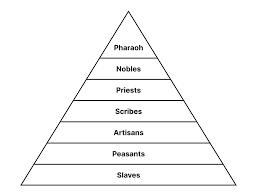Welcome, esteemed readers and cultural explorers, to a captivating dive into the intricate social structure that shaped the fascinating civilization of Ancient Egypt. Join us as we unravel the layers of society, from pharaohs to peasants, and uncover the hierarchies that governed Egyptian life. Presented by Top Ten Egypt, the premier travel agency in the land of pharaohs, this article finds its rightful place within the “History of Egypt” category, inviting you to embark on an enlightening journey through time.
The Pyramid of Power:
At the apex of Ancient Egyptian society stood the revered pharaohs, the god-kings who expertly ruled over the Nile Valley and beyond. They were believed to be the intermediaries between the mortal realm and the divine, ensuring harmony and prosperity for their subjects. Clad in regal splendor and surrounded by a court of influential advisors, viziers, and high-ranking officials, the pharaohs exemplified the pinnacle of power and authority.
Nobles and Priests:
Directly beneath the pharaohs, the nobles and priests occupied esteemed positions within the social framework. The nobility wielded substantial influence and played pivotal roles in administering vast territories, managing agriculture, and overseeing regional governance. Priests, on the other hand, held spiritual significance, presiding over ceremonies, conducting rituals, and ensuring the favor of the gods. Their duties intertwined with everyday life as they sought divine guidance and appeasement.
Scribes and Administrators:
Scribes held a unique position in Ancient Egyptian society, symbolizing knowledge, literacy, and the art of record-keeping. They were responsible for maintaining meticulous records, drafting legal documents, and conducting correspondence on behalf of the ruling elite. Scribe schools imparted specialized education to cultivate these invaluable skills, and scribes were often rewarded with positions in the royal bureaucracy.
Craftsmen and Tradesmen:
The skilled craftsmen and tradesmen formed an essential segment of Egyptian society, possessing expertise in various fields such as masonry, carpentry, pottery, jewelry-making, and painting. Their remarkable craftsmanship embellished the grand temples, majestic tombs, and exquisite artifacts that still mesmerize the world today. These artisans played an integral role in constructing the physical manifestations of Egypt’s rich cultural heritage.
Peasants and Laborers:
The backbone of Egyptian society comprised the hardworking peasants and laborers, who formed the agricultural workforce and contributed to the nation’s sustenance. Engaged in farming, irrigation, and animal husbandry, they toiled under the scorching sun, tending to the fertile lands along the Nile. Their unwavering dedication and labor ensured the food supply vital for the stability and prosperity of the entire civilization.
Journeying Through Ancient Hierarchies:
Embark on an enthralling voyage through the remnants of an extraordinary society with Top Ten Egypt’s curated tours and experiences. Marvel at the grandeur of monumental structures, witness the intricate craftsmanship of ancient artisans, and explore the ruins that whisper tales of bygone lives. Through our immersive adventures, you will discover how the social structure of Ancient Egypt forged a civilization that flourished for millennia.
As we unveil the captivating tapestry of the Ancient Egyptian social structure, we stand in awe of the hierarchical order that defined this majestic civilization. Top Ten Egypt invites you to embrace the intrigue and splendor of Egypt’s rich history through our exceptional array of tours and itineraries. Immerse yourself in the world of pharaohs, priests, nobility, craftsmen, and peasants, and witness the enduring legacy of an exceptional society.
For those who yearn to unravel the secrets of the past, Ancient Egypt beckons, awaiting your exploration amidst the timeless sands of the Nile.



Comment (0)